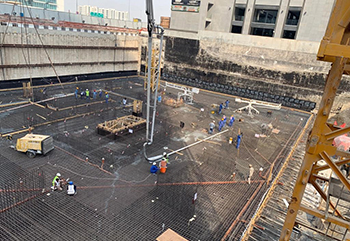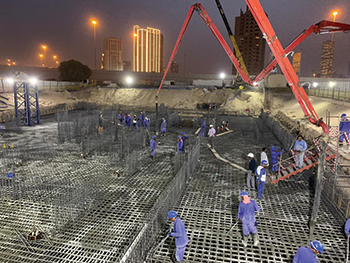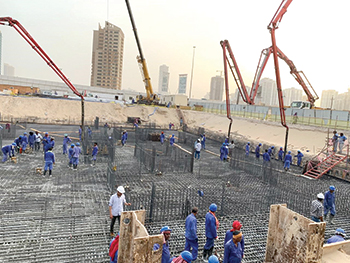
 Admixtures play a key role in effective pumping of concrete.
Admixtures play a key role in effective pumping of concrete.
Admixtures are used to modify the properties of concrete either in its plastic state, hardened state, or both. When used properly, they can confer a variety of advantages, including improved concrete strength or durability, decreased permeability, corrosion reduction, increased slump and workability, improved pumpability and more.
Hence, understanding an admixture’s effect on a concrete mixture and ensuring compatibility between all ingredients – especially when adding multiple admixtures – is critical.
There are many admixtures on the market with wide scope in their technology, chemistry and function.
 |
|
Environmental conditions can affect the behaviour of a concrete mixture once it is on-site. |
Challenges
Here in the Gulf, the primary environmental challenges are the hot, windy climate and the combination of chlorides and sulfates in the soils. Hot weather can cause slump loss in fresh concrete, which decreases its workability.
Admixtures that can successfully be used to combat slump loss include high-range water-reducers (also known as superplasticisers) such as melamine sulfonate polycondensation products and naphthalene sulfonate, as well as workability-retaining admixtures used in combination with normal-, mid-, or high-range water reducers (these are dispersants such as polycarboxylates).
High-rise structures being built in the Gulf region depend upon concrete pumping for placement. In addition to water-reducing admixtures, air-entraining admixtures may be used to maintain pumpability. These include salts of wood resins, some synthetic detergents, salts of sulfonated lignin, salts of petroleum acids, salts of proteinaceous material, fatty and resinous acids and their salts, tall oils and gum rosin salts, alkylbenzene sulfonates, and salts of sulfonated hydrocarbons.
Corrosion inhibitors are common admixtures used to combat the increased corrosivity of chlorides and sulfates that may be present in the environment (or even in concrete mix materials). These include amine carboxylates, aminoester organic emulsion, calcium nitrite and organic alkyidicarboxylic, as well as chromates, phosphates, hypophosphites, alkalis and fluorides.
Not only are soils in the Gulf region frequently contaminated with corrosive agents, but the load-bearing capability of soil is often an issue. When this is the case, buildings may incorporate thicker mat slabs to achieve structural stability. In thick slabs, heat of hydration needs to be managed and admixtures may be considered to improve curing and shrinkage.
Permeability-reducing admixtures (PRAs) may be used in place of physical waterproofing membranes. Unlike physical barriers, which can degrade over time, PRAs provide integral protection of the concrete using various mechanisms. Some PRAs may create repellency and reduce water absorption, others may block the concrete pores or grow pore-blocking materials.
In non-hydrostatic conditions, the admixtures may be long-chain fatty acid derivatives such as stearic, oleic or caprylic capric; soaps and oils such as tallows or soya-based; petroleum derivatives such as mineral oil, paraffin, or bitumen emulsions; and fine particle fillers such as silicates, bentonite or talc.
In hydrostatic conditions, the admixtures may be hydrophilic crystalline or polymers such as latex or water-soluble/liquid polymers.
In addition to reducing the permeability of concrete, some PRAs may offer other benefits such as reducing drying shrinkage, lowering chloride ion penetration, causing sulfates to deteriorate on contact, enhancing freezing-and-thawing resistance and self-sealing with the ingress of water.
Concrete mixtures in the Gulf states often incorporate high percentages of slag in order to comply with governmental sustainability regulations, with some mixtures containing as much as a 70 per cent slag replacement for portland cement. This should also be considered when choosing admixtures.
 |
|
Admixtures can improve concrete strength and pumpability and reduce corrosion. |
Admixture combinations
Since it is not uncommon for three or more admixtures to be used in a given concrete mixture, specifiers must assess how those admixtures will interact.
The choice of admixture should be based on the required water content; water-to-cementitious-materials ratio (w/cm); compressive and flexural strengths; air content; target slump or slump/flow; setting times; early strength development, if required; and ultimate compressive and flexural strengths. The overall admixture combination should require the least amount of water necessary to achieve the correct slump and setting time.
It is necessary to perform a trial pour in the field and not rely solely on results obtained in a laboratory setting.
Environmental conditions, such as air temperature or wind, can dramatically affect the behaviour of a concrete mixture once it is on-site. Therefore, a concrete mixture with a unique or unproven combination of admixtures should be tested in the conditions for which it will be used. For example, if it is going to be pumped at high pressure, then it should be tested at high pressure with variables such as equipment temperature accounted for.
In some construction projects, it may be possible to accomplish test placements by using the test batch to construct footers or other accessible areas of the building. On-site test placements should verify workability, finishability, pumpability, setting time, and other characteristics required in the plastic state.
The order in which admixtures are added to the concrete mixture can result in different chemical or physical behaviour. Therefore, it is important to add admixtures to a concrete batch separately, with no intermixing beforehand. The concrete producer, with assistance from technical representatives of admixture suppliers, should determine the batching order or sequence for incorporating admixtures.
In the absence of information suggesting otherwise, ACI 212.3R-16, ‘Report on Chemical Admixtures for Concrete’ suggests the following as a generally appropriate for batching chemical admixtures:
• Air-entraining admixtures;
• Water-reducing admixtures (Type A, water-reducing admixtures; or Type D, water-reducing and retarding admixtures);
• Retarding admixtures;
• Accelerating admixtures;
• High-range water-reducing admixtures;
• Permeability-reducing admixtures;
• Shrinkage-reducing admixtures;
• Corrosion-inhibiting admixtures; and
• Viscosity-modifying admixtures.
The report, which provides guidance on the use of admixtures for specifiers, includes a chapter reference guide that directs users to relevant sections based on concrete requirements and exposures.
The document further recommends the use of either high-range water-reducing admixtures or air-entraining admixtures, or both, if it is subsequently necessary to increase slump, air, or both.
Changing technologies
Buildings must accommodate increasing amounts of reinforcing materials, not only to support taller heights but also to help them meet new design goals such as seismic resistance. Self-consolidating concrete (SCC) offers a good solution in such scenarios because it achieves consolidation in areas where reinforcing steel is too tightly spaced to physically compact.
SCC can benefit from viscosity-modifying admixtures (VMAs), which help accomplish a monolithic pour as well as reduce cracking in the finished concrete. VMAs are typically water-soluble polymers that modify concrete’s rheological properties. Rheology is the science dealing with deformation and flow of materials, whereas viscosity refers to the resistance of motion under an applied force.
Common VMAs are polyethylene oxides, cellulose ethers (hydroxyethyl cellulose and hydroxypropyl methylcellulose), alginates (from seaweed), natural and synthetic gums and polyacrylamides or polyvinyl alcohol. Other materials used include finely divided solids such as starches, clays, lime and polymer emulsions.
When a VMA is used in an SCC mixture, its dosage should be optimised to achieve a non-segregating mixture. The rheology of the SCC mixture should be measured using a concrete rheometer. Viscosity can be measured using a V-funnel test and the T50 time, as per ASTM C1611/C1611M. VMAs that increase plastic viscosity and do not increase the yield stress of concrete are preferable.
VMAs are also often used in pumped concrete, where high pump pressures can separate the mortar fraction from the concrete mixture and lead to agglomeration of coarse aggregates that can block the line. VMAs can make the mixture cohesive and prevent choking of the pump.
* American Concrete Institute (ACI) is a non-profit technical society and standards developing organisation. It is a leading authority and resource worldwide for the development, dissemination, and adoption of its consensus-based standards, technical resources, educational and training programmes, certification programmes, and proven expertise for individuals and organisations involved in concrete design, construction, and materials.





















_0001.jpg)


.jpg)
















.jpg)








.jpg)


